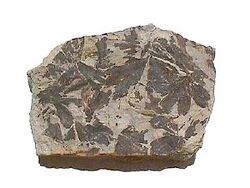Biology:Ginkgo huttonii
| Ginkgo huttonii | |
|---|---|

| |
| Scientific classification | |
| Kingdom: | Plantae |
| Clade: | Tracheophytes |
| Clade: | Gymnospermae |
| Division: | Ginkgophyta |
| Class: | Ginkgoopsida |
| Order: | Ginkgoales |
| Family: | Ginkgoaceae |
| Genus: | Ginkgo |
| Species: | †G. huttonii
|
| Binomial name | |
| †Ginkgo huttonii (Sternb.) Heer
| |
Ginkgo huttonii is an extinct Ginkgo species in the family Ginkgoaceae from the Jurassic of England . The fossil is also known by the name, Ginkgoites huttonii, the genus, Ginkgoites, referring to a group of extinct members of the Ginkgoaceae. G. huttonii was a broad-leaved, deciduous gymnosperm[1] bearing resemblance to the only living member of the Ginkgoaceae, Ginkgo biloba.[2]
Description
Ginkgo huttonii is known largely by compression fossils of its leaves. Similar to other members of the Ginkgoites, the fossil leaves of G. huttonii are simple, four-lobed, and have dense, radially disposed venation.[3][2] G. huttonii fossil seeds are frequently found as well as at least a few fossilized male catkins.[4] G. huttonii wood has yet to be described but it is likely the plant was similar to the extant, G. biloba, with wood akin to that of modern day conifers.[5]
Distribution
G. huttonii is heavily represented in the Jurassic flora of Yorkshire, England - a flora which has been studied in depth since the 1800s.[5][6] The order Ginkgoales had a wide distribution throughout the northern hemisphere from the Lower Jurassic through the Cretaceous.[7]
Discovery
G. Huttonii was discovered in the 1800s when excavation began throughout the Yorkshire formation. The fossil was first described by Oswald Heer.
References
- ↑ Ernest M. Gifford (1998). "Ginkgophyte". Encyclopaedia Britannica, Inc.. https://www.britannica.com/plant/ginkgophyte.
- ↑ 2.0 2.1 Villar de Seoane, Liliana (1997). "Comparative study between Ginkgoites tigrensisArchangelsky and Ginkgo bilobalinn. leaves". Palaeobotanist 46 (3): 1–12. http://14.139.63.228:8080/pbrep/bitstream/123456789/1854/1/PbV46N3_1.pdf.
- ↑ Nosova, Natalya; Zhang, Jian-Wei (August 2011). "Revision of Ginkgoites obrustschewii (Steward) Seward (Ginkgoales) and the new material from the Jurassic of Northwestern China". Review of Palaeobotany and Palynology 166 (3–4): 286–294. doi:10.1016/j.revpalbo.2011.06.002. https://www.sciencedirect.com/science/article/pii/S0034666711000777?casa_token=I9T-2zaKI5gAAAAA:K34j71AvMzFwazgIAMQxb6debsKkpjsrqIkkwjuOe1kZIxDe9mrSZWAeeVSGjYfFfrlgARYt.
- ↑ Steur, Hans (March 1, 2020). "Ginkgo-like plants from Yorkshire". https://steurh.home.xs4all.nl/engyork/eyorkgkg.html.
- ↑ 5.0 5.1 H.A. van Konijnenburg-van Cittert, Johanna (2008). "The Jurassic fossil plant record of the UK area". Proceedings of the Geologists' Association. https://www.academia.edu/23213646.
- ↑ M. Slater, Sam; H. Wellman, CHarles; Romano, Michael; Vajda, Vivi (2018). "Dinosaur-plant interactions within a Middle Jurassic ecosystem-palynology of the Burniston Bay dinosaur footpring locality, Yorkshire, UK". Palaeobiodiversity and Palaeoenvironments 98: 139–151. doi:10.1007/s12549-017-0309-9. https://link.springer.com/article/10.1007/s12549-017-0309-9.
- ↑ "Ginkgoales: Fossil Record". UC Berkeley. 1997. https://ucmp.berkeley.edu/seedplants/ginkgoales/ginkgofr.html.
External links
Wikidata ☰ Q5563153 entry


